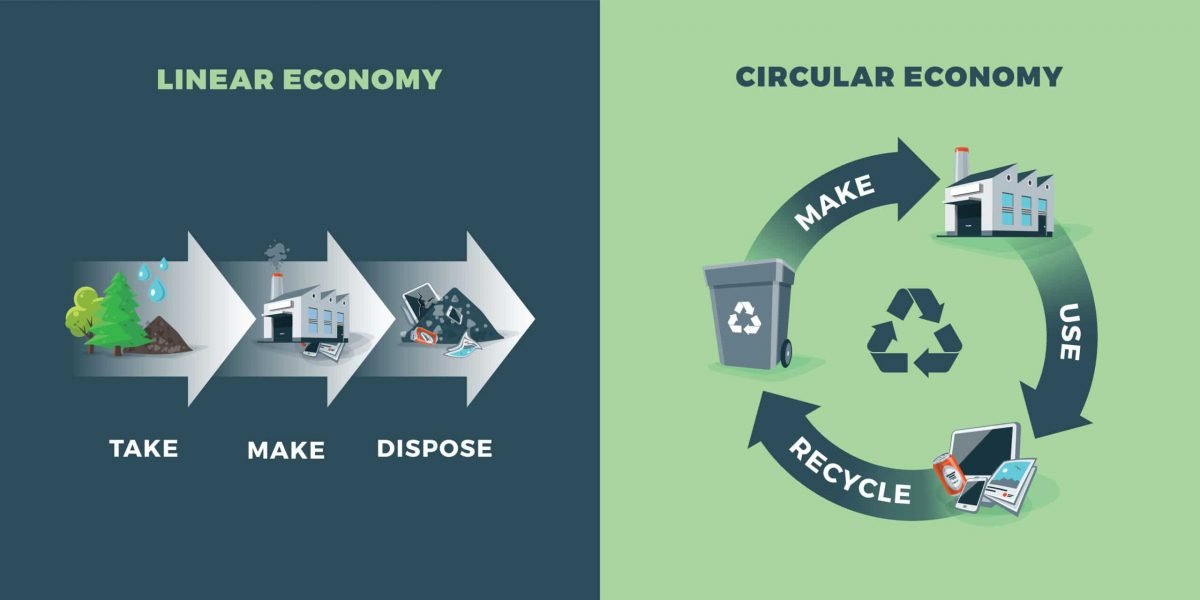Our economy can be likened to a natural cycle. Goods and services are exchanged for currency equal to their value and that money is distributed, oiling the cogs in the wheel of the supply chain. But often, portions of the cycle go underutilized, creating waste or stagnation. These ruts leave physical evidence. In fact, they have been causing blockages that can be seen all over our planet: usable materials dumped in landfills and plastics floating freely in the depths of the ocean, clogging the arteries of the natural cycle in the name of economic prowess. But what if there was a way to recover the waste products of the supply chain cycle – furthering their lives, saving money and preserving finite resources? Such is possible by utilizing the concepts of the Circular Economy.
The Circular Economy embraces systemic change through the continuous reuse of resources to eliminate waste. The concept encourages reusing, repurposing, refurbishing, recycling and other methods to increase the lifespan of a resource and establish a closed loop system. Originally developed through the work of several environmental economists, the circular economy draws from elements of numerous closed-loop economic theories that embrace natural systems; cradle-to-cradle, regenerative design, industrial ecology, biomimicry and blue economy being a few.
The Linear Consumption Model
Since the dawn of the industrial revolution, gaps in the understanding of our limited resources have set up a system that “takes, makes, disposes.” Our current market functions as follows: companies extract raw materials, then use them to produce a finished product and finally sell their products to consumers who use them for a finite period before disposing of them. Such a system is problematic for several reasons:
- The often-unpredictable costs of raw materials are squeezing companies who are producing products in a competitive market
- The efficiency of the manufacturing process is limited
- Risks are increasing with such a fragmented, global supply chain
- The finite supply of raw materials for both energy and production will continue to deplete as time goes on
Use Cases for the Circular Economy
Slowly but surely, businesses are understanding the effectiveness and reach of a circular economy as a better model for economic progress, impacting both their bottom line and overall industry standards. Several large companies have altered their operations to meet the guiding principles of the movement. These changes have allowed them to save substantially on manufacturing costs and work towards a more wholesome supply chain model. A study done by the World Economic Forum sites numerous success stories of companies who have adopted the model. These include:
Where We Are in Progress
The transition to a fully circular model will take time, as changing the mindset of consumers, manufacturers, distributors, and executives is no easy task. However, a new age of conscious consumption appears to be on the horizon. A rise in emerging brands who have embraced the circular economy cannot be overstated. From apparel to agriculture, service models and brick and mortar products alike have been slowly shifting to embrace a more cyclical and transparent supply chain and product lifespan. Brands like Imperfect Foods have started capitalizing on the waste by-products of the traditional system, appealing to conscious, concerned consumers. Apparel companies such as Patagonia, All Birds and Rothy’s have built sustainable practices into their supply chain model, sourcing their materials using secondhand products. And, suppliers such as #tide have been distributing their recycled source materials to a whole line of sustainable brands. As traction increases from both big and small brands, the global transformation is well underway.
The Future is Now
As the practical business applications of a circular model continue to disrupt the linear model with full steam ahead, it falls upon consumers to demand transparency and encourage businesses to make the transition. The wave of conscious consumption that has started to revolutionize our business practices depends on unanimous support from all stakeholders in the process. It will not be long before the rising tide of ethics-driven products and end-user support flood the market and galvanize worldwide adoption of Circular Economics.
Increasing the lifespan of goods and materials in every phase of the supply chain will change the way the world looks at the finished products in its hands. In the meantime, we ask consumers to contemplate the powers of such a robust model and to start incorporating the principles in daily life. Before throwing something away, ask: how can you give it a second life?
